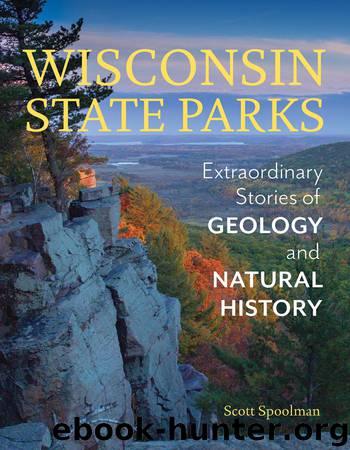Wisconsin State Parks: Extraordinary Stories of Geology and Natural History by Scott Spoolman

Author:Scott Spoolman [Spoolman, Scott]
Language: eng
Format: epub
Publisher: Wisconsin Historical Society Press
This is a 2.3-mile trail rated as difficult by the park. Most of this trail is wide, well maintained, and well marked, but it has a few very steep sections that can be bypassed on alternative routes. In addition to being a good hiking trail, it makes an excellent—although difficult—cross-country skiing trail.
The trailhead is behind the park entrance office across the entrance road. Several cutoff trails allow you to shorten the loop, but by bearing right at the forks on this trail, you take the outermost loop, which gives you a chance to warm up on the flatter first half of the trail before tackling the hillier second half. After one-tenth of a mile, the trail passes the south end of the tributary section of the lake on which the beach is located farther up the shore on the east side of the lake. The trail crosses the stream that feeds this part of the lake on a sturdy wooden bridge and then forks. The right fork runs in a northerly direction along the west side of the lake.
The forest along the trail is typical of the surrounding area. The first part of the trail runs through a forest of mostly maple with a few white pine, which shortly gives way to more white pine and oak as you go farther north. Starting at the 0.8-mile mark, the trail crosses short drainage valleys running steeply down out of highland woods toward the lake.
At close to a mile, the trail passes to the right of the foundation of an old building: the Page family’s eight-bedroom summer home. These ruins are steadily being reclaimed by the forest. A little farther on, the trail passes an old cement-and-steel guardrail on the right, separating the trail from the steep decline to the lake. It bordered an old road that served the landowner in days gone by.
The trail next passes through open woods parallel to the bluff next to the lake. It is studded with large old white pines—the closest thing to old-growth forest in the area. The scene harkens to days when white pine forests dominated most of Wisconsin before they were logged off by the early twentieth century. At the 1.2-mile mark, the trail leaves the bluff area and turns south into deeper woods. The sand underfoot becomes more evident here, as red pines now join the mix of trees. They like sandy soil.
About 1.4 miles from the trailhead, you see a high sandstone outcropping off the trail to the left. It looks as if it could be a secondary river bluff lying inland from the creek. In glacial times, when the ice was melting and Dell Creek was wider and deeper, this cliff probably formed the riverbank. The trail wraps around and ascends to the top of this outcropping, then levels off.
After another third of a mile, you enter a much hillier area. There are three points on the trail where you have a choice between a steep section and a more level bypass.
Download
This site does not store any files on its server. We only index and link to content provided by other sites. Please contact the content providers to delete copyright contents if any and email us, we'll remove relevant links or contents immediately.
In a Sunburned Country by Bill Bryson(3376)
Annapurna by Maurice Herzog(3305)
How to Read Nature by Tristan Gooley(3089)
Dangerous Girls by Haas Abigail(2846)
SAS Survival Handbook by John 'Lofty' Wiseman(2583)
The Lost Art of Reading Nature's Signs by Tristan Gooley(2551)
In the Woods by Tana French(2424)
The Stranger in the Woods by Michael Finkel(2332)
Food and Water in an Emergency by Food & Water In An Emergency(2274)
Guns, Germs and Steel by Diamond Jared(2206)
Wild: From Lost to Found on the Pacific Crest Trail by Cheryl Strayed(2146)
Everest the Cruel Way by Joe Tasker(2135)
Backpacker the Complete Guide to Backpacking by Backpacker Magazine(2112)
Trail Magic by Trevelyan Quest Edwards & Hazel Edwards(2065)
Ultimate Navigation Manual by Lyle Brotherton(2057)
Sea Survival Handbook by Keith Colwell(2046)
Welcome to the Goddamn Ice Cube by Blair Braverman(1889)
Birds of the Pacific Northwest by Shewey John; Blount Tim;(1877)
The Last Flight by Julie Clark(1845)
